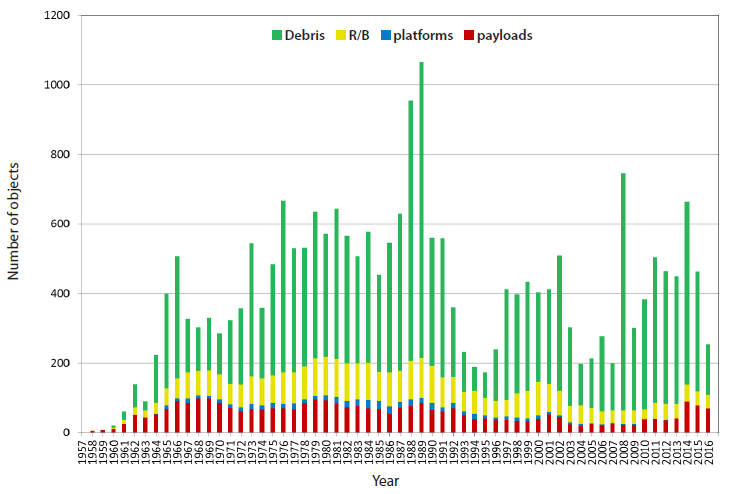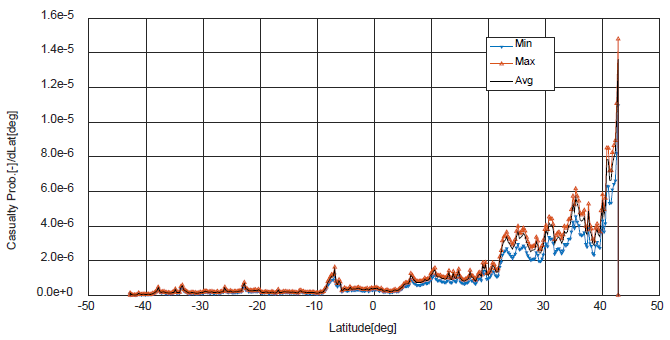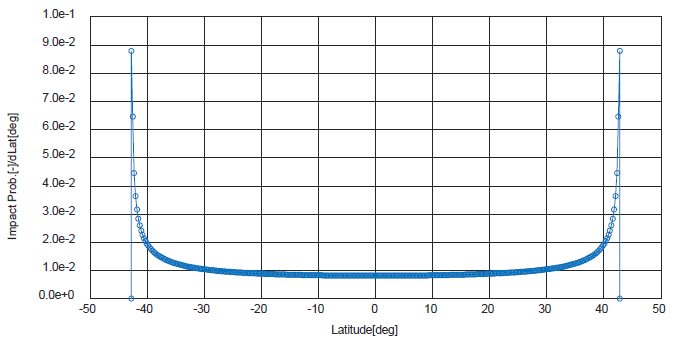1 INTRODUCTION
The threat posed by debris from space has become an important global issue, and space situational awareness (SSA) is emerging as a new agenda for space development. SSA is invariably linked to threats and hazards, but SSA can also provide opportunities to mitigate or reduce hazards (Kennewell & Vo 2013). In particular, SSA has been recognized as an essential prerequisite for the safe conduct of space activities. The high-level SSA objective is to provide users with dependable, accurate, and timely information to support risk management during on orbit and re-entry, and to support the safe and secure operation of space assets and related services (Del Monte 2007a, 2007b; Rathgeber 2008a, 2008b).
Since the launch of the first artificial satellite, Sputnik I, in 1957, space activities have created orbital debris that pose an increasing risk to existing space systems. One of the particular hazards is caused by the fact that many orbiting space objects eventually re-enter Earth’s atmosphere. Currently, according to the box scores from the Satellite Situation Report issued on September 7, 2017, 42,939 artificial space objects have been registered as orbiting Earth, of which 18,764 are in Earth orbit and 24,175 have already burned up in the atmosphere (Space-Track 2017). In summary, approximately 56.3 % of the total number of registered objects has fallen to the Earth. Fig. 1 shows the summary of all the objects orbiting Earth that have been officially catalogued as objects by the US Space Surveillance Network, including the objects’ regions (NASA Orbital Debris Program Office 2017). “Fragmentation debris” includes satellite break-up debris and anomalous event debris, while “mission-related debris” includes all objects dispensed, separated, or released as part of a planned mission. According to the report of the Aerospace Corporation (Aerospace 2017a), 200 to 400 space objects that are large enough to be tracked typically re-enter each year, as shown in Fig. 2. During re-entry, space objects may break into many pieces of debris at altitudes of approximately 75 to 85 km. Generally, most of the debris is completely burned up, but surviving fragments from the re-entry of space objects can cause a non-negligible risk to persons and properties on the ground. There are two types of re-entry: controlled and uncontrolled. For controlled re-entries, the re-entry target zone can be chosen to avoid populated areas of Earth. However, in case of uncontrolled re-entries, it is very difficult to accurately predict the re-entry time and location (Matney 2011). In particular, the re-entry of large inoperable nuclearpowered satellites carries a risk of disaster. On January 24, 1978, Cosmos 954, a Soviet maritime reconnaissance satellite, crashed in northwestern Canada. This crash scattered numerous contaminated radioactive components from the satellite’s nuclear reactor (Tsujino 2012). It is critical to note that satellites with on-board nuclear reactors of the same model are still orbiting Earth and require continued monitoring.
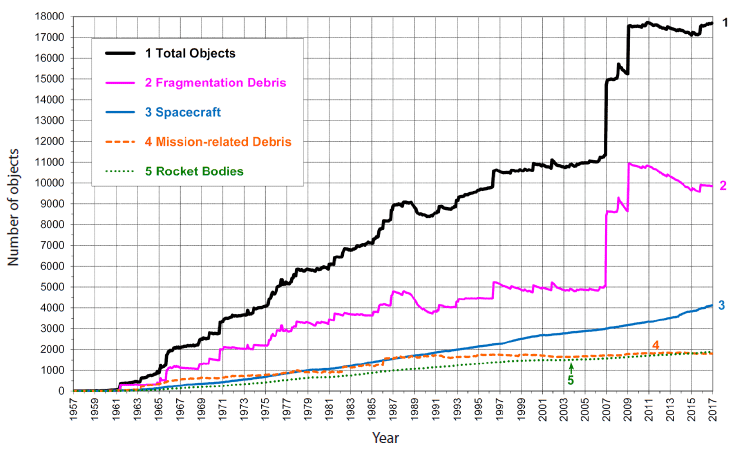
In Korea, official operation of the satellite re-entry monitoring room was initiated in response to the re-entry of Cosmos 1402, the Soviet Union’s nuclear-powered satellite, in 1983, which caused radioactive contamination issues. At that time, the first task-force team for re-entry analysis was set up in the Korea Astronomy and Space Science Institute (KASI) (Jo et al. 2013; Park et al. 2015; Lee et al. 2017). After this event, the official satellite re-entry monitoring room was retained to monitor and analyze data and to inform the public, under the supervision of the KASI, concerning the re-entry of the Russian MIR space station in 2001, the United State (US) upper atmosphere research satellite (UARS) in 2011, the German satellite Roentgen in 2011, the Russian space explorer Phobos-Grunt in 2012, the Russian satellite Cosmos 1484 in 2013, the European geodetic satellite gravity field and steady-state ocean circulation explorer (GOCE) in 2013, and the Russian cargo for the international space station (ISS) Progress M-27M in 2015.
As the need for a space risk response increased, the national preparedness plan for space hazards was established in 2014 (Choi et al. 2014). According to this plan, Korea’s space situational awareness program was formally launched on January 31, 2015 by the establishment of the National Space Situational Awareness Organization (NSSAO) (Choi et al. 2015a, 2015b).
Owing to the increasing frequency of spacecraft reentry situations, fast and accurate re-entry predictions and ground risk assessments for SSA are needed, and this has become an important and active research area in recent years. The National Aeronautics and Space Administration (NASA), European Space Agency (ESA), Centre National d’Etudes Spatiales (CNES), and other organizations have already studied and developed representative tools for predicting and analyzing spacecraft re-entry and ground risk assessments (Wu et al. 2011).
In this study, we investigated the key elements of re-entry predictions through analyzing several representative tools, including the object re-entry survival analysis tool (ORSAT) and debris assessment software (DAS) developed by NASA, the spacecraft atmospheric re-entry and aerothermal break-up (SCARAB) and debris risk assessment and mitigation analysis (DRAMA) developed by ESA, and the semi-analytic tool for end of life analysis software (STELA) developed by CNES (Dobarco-Otero et al. 2003; Dobarco- Otero et al. 2005; Lips 2013; CNES 2013; ESA/ESOC 2017). A performance analysis of the advantages and disadvantages of the representative re-entry object analysis tools, focusing particularly on the up-to-date analysis tool STELA, was carried out. Results show that STELA performs well in longterm predictions of the lifetime of a space object during reentry, and DRAMA provides an effective solution for ground risk assessments.
Based on the ideas discussed above, we propose an efficient new analysis method for both re-entry predictions for space objects and ground risk assessments by integrating key features of STELA for long-term predictions and DRAMA for ground-impact risk analyses. To check the performance of the newly proposed approach that integrates STELA and DRAMA, an analysis of the re-entry prediction for the Tiangong-1 Space Lab, China’s first space station, was carried out. This study will facilitate efficient preparation for upcoming uncontrolled re-entry events.
2 THE HISTORY OF RE-ENTRY EVENTS
Many space objects in orbit eventually re-enter Earth’s atmosphere. Since the launch of the first satellite in 1957, more than 24,000 artificial objects, as catalogued by Space- Track, have returned to Earth so far (Space-Track 2017). Typically, 200 to 400 objects crash into Earth annually, corresponding to about 50 % of the total returning mass of objects, i.e., approximately 100 metric tons per year (Pardini & Anselmo 2013; Pardini & Anselmo 2016a; Aerospace 2017a). Table 1 lists the re-entry of space objects in September 2017. During re-entry, space objects may be broken into many pieces of debris at altitudes of approximately 75 to 85 km. Typically, the specific mechanical energy is predominantly converted into heat energy and only a small fraction of this energy is absorbed by the re-entering objects. However, some surviving components from large objects can cause a non-negligible risk to persons on the ground (Klinkrad 2006). Usually, approximately 10 to 40 % of a space object’s mass is expected to re-enter, but the actual percentage for a specific object depends on the materials used in the object’s construction, and on the object’s shape, size, and weight. There are two kinds of re-entry: controlled and uncontrolled. For controlled re-entries, the re-entry target zone can be chosen to avoid populated areas on Earth. However, in cases of uncontrolled re-entry, it is very difficult to achieve the required accuracy when predicting re-entry locations and timings (Matney 2011).
Representative cases of controllable re-entry accidents include the US Skylab and the Russian space station MIR. US Skylab was on standby for its disuse after completing its mission in a low earth orbit (LEO). However, due to sudden solar activity, the re-entry of the 75-ton Skylab space station took place earlier than expected on July 11, 1979. At this moment, a re-entry disaster was predicted with 1:152 incidences of accidents involving human life. Owing to the NASA control team’s successful communication with Skylab, together with posture control of the space station, the team was able to lessen the damage by inducing Skylab to drop into the Perth district of Western Australia. The largest historical re-entry risk associated with a space object was the 135-ton MIR space station. The Russian MIR space station performed its mission for 15 years, which was three times the initial planned operational lifespan. However, owing to frequent accidents caused by issues with the fuselage, the lifespan was reduced, and it was de-orbited in a controlled manner into an uninhabited area in the South Pacific Ocean near New Zealand, and the associated risk was close to zero on March 23, 2001.
Compared with controllable space objects, uncontrollable space objects are more significantly influenced by external disturbing forces, meaning that it is very difficult to predict their movements. Typical cases include the tragic loss of the Space Shuttle Columbia and the demise of the Russian reconnaissance satellite Cosmos 954. The Space Shuttle Columbia exploded due to a wing crack at the time of reentry after completing its 28th flight in 2003. The disaster killed all seven crew members and more than 80,000 fragments dropped into the State of Texas. The damage covered approximately 72,520 km2 (CAIB 2006). A large amount of property was damaged but, fortunately, there were no additional losses of human lives. On January 24, 1978, Cosmos 954 re-entered over the Northwest Territories of Canada due to a malfunction in the nuclear reactor mounted on this satellite. As it fell into suburbs remote from denselypopulated areas, direct damage due to satellite fragments were slight. However, numerous radioactive fragments from the nuclear reactor collected on the ground over a length of more than 1,000 km (Klinklad 2006). Even though they are relatively less frequent, the recent significant uncontrolled re-entries dominate considerable media attention, e.g., the re-entries of the satellites UARS (2011), Roentgen (2011), Phobos-Grunt (2012), Cosmos 1484 (2013), GOCE (2013), and Progress M-27M (2015). The KASI, responsible for official monitoring of re-entry satellites, has executed monitoring, data analysis, official reporting, and public announcements under the supervision of the government (Jo et al. 2013, KASI Satellite Reentry Monitoring Room 2017).
NASA’s UARS had a dry mass of 5,668 kg, a diameter of 4.6 m, a length of 9.7 m, and a complex shape. According to NASA, twenty-six satellite components, with a total surviving mass of 532 kg, could have survived re-entry and landed in the Pacific Ocean far off the US coast on September 24, 2011. In a similar manner to the UARS satellite, the Deutsches Zentrum für Luftund Raumfahrt e.V. (DLR)’s Roentgen (X-ray) satellite (ROSAT), with a dry mass of 2,426 kg, re-entered the atmosphere without control on October 23, 2011. The Roscosmos’ 13,525 kg unmanned Phobos-Grunt interplanetary space probe decayed on January 15, 2012. More than 82% of the total mass, i.e., approximately 11,150 kg, consisting of toxic liquid hypergolic propellants and radioactive cobalt-57, fortunately broke up over an uninhabited sea area, 1,250 km west of Chile in the South Pacific (Pardini & Anselmo 2012; Anselmo & Pardini 2013). The ESA’s GOCE satellite, with a dry mass of 1,002 kg, re-entered over the South Atlantic Ocean near the Falkland Islands on November 11, 2013. An estimated 25 % of its total mass reached Earth’s surface. An international campaign, involving the Inter-Agency Space Debris Coordination Committee (IADC), monitored the reentry. A Falkland Islander managed to catch COGE on camera as it disintegrated and burned up in the atmosphere (Virgili et al. 2015). The cargo ship Progress M-27M encountered severe problems immediately after launch, was declared officially lost on April 29, 2015, and re-entered 9 days later (Pardini & Anselmo 2016a, 2016b). In its total launch mass of 7,289 kg, it contained 1,373 kg of highly toxic propellants. According to a US Space Command (USSTRATCOM) announcement, the location of re-entry was 830 km off the Chilean Coast, but final location should be expected anywhere from 350 to 1,300 km off the South American Coast (Spaceflight101 2017).
3 A BRIEF OVERVIEW OF RE-ENTRY ANALYSIS TOOLS
Over six decades of space activity, re-entry predictions and ground risk assessments have become increasingly important and necessary. However, predicting the reentry time and location of an uncontrolled space object remains a very difficult task. Considerable uncertainty exists in re-entry predictions due to sometimes sparse and inaccurate tracking data, the complex shapes and unknown attitude evolution of the re-entering object, inaccuracies in the atmospheric density data at the altitudes of interest, prediction errors of solar and geomagnetic activity, incorrect modeling of drag coefficients, etc. The uncertainty in the event time reduces as the date of re-entry approaches (Pardini & Anselmo 2013), but even one day in advance, the estimation may still include a margin of error of several hours. Therefore, even applying the same models, methods, and procedures, the overall relative re-entry predictions may be quite different for different objects, and relative errors of 20 % often occur (Pardini & Anselmo 2012, 2013).
However, specific methods and procedures have been developed to provide clear and unambiguous information. Well-known space agencies and research institutes, such as NASA, ESA, CNES, and other organizations, have studied and developed diverse methods and tools for predicting and analyzing the re-entry of space objects and associated ground-risk assessments.
Representative tools include DAS and ORSAT, developed by NASA, and SCARAB and DRAMA, developed by ESA. Recently, CNES developed STELA, which provides an efficient solution for long-term predictions that compute the lifetime of satellites and for risk analyses of the impact of space debris on the ground. However, no systematic comparison analysis of the performance of the STELA tool currently exists.
Re-entry analysis tools usually require geometric and physical models of the spacecraft and of its elements, and include the following analyses: flight dynamics, aerodynamic and aerothermal analysis, local heating and melting process analyses, break-up processes, and fragmentation tracking till ground impact (Lips & Fritsche 2005). The available analysis tools can be classified as spacecraft-oriented methods or object-oriented method (Lips & Fitsche 2005; Wu et al. 2011; Bandlamudi et al. 2014).
Spacecraft-oriented methods simulate spacecraft reentry using a model as similar to the actual spacecraft as possible. ESA’s SCARAB is the only tool of this type, and it can directly predict the break-up altitude through complex computations. The spacecraft-oriented method gives more accurate results than the object-oriented method. However, it requires detailed information relating to satellite parameters for precise modeling, and usually requires greater modeling efforts and computational resources than the spacecraft-oriented method owing to its complex analysis strategy.
In contrast, the object-oriented method provides an efficient solution by simplifying complex satellite shapes into simple forms, like sphere, cylinder, flat plate, box, etc. Most of the available tools, except SCARAB, are classified as object-oriented methods. One of the key features of these methods is that they have simplified the computation process, including break-up altitude determinations. In general, the determination of satellite break-up altitude requires a prediction using various variables relating to flight dynamics, thermal fluid dynamics, the structural mechanics of a satellite, etc. The object-oriented method assumes that the re-entry of space objects predominantly occurs at an altitude 78 km below the actual break-up altitude. The basic concept for space objects’ re-entry and ground impact is shown in Fig. 3. The break-up altitude is usually between 75 and 85 km, and the model determines a ground impact footprint for the surviving fragments. The footprint of fragments varies according to the break-up conditions (altitude, position, velocity) and the parameters of the fragments (ballistic coefficients, mass, shape, etc.).
This study reviews the existing re-entry analysis tools, emphasizing the advantages and disadvantages of representative re-entry object analysis tools, specifically including the up-to-date analysis tool STELA.
SCARAB was developed by a German Company, Hypersonic Technology Göttingen (HTG), at the request of ESA in 1995. ESA carried out an accurate re-entry analysis using this tool (Lips et al. 2004, Lips 2013). SCARAB’s original concept was based on a deterministic approach, which requires a realistic physical model of the spacecraft and corresponding analysis methods. This approach may be questionable due to the unknown initial conditions for uncontrolled re-entry of space objects. The spacecraft model in SCARAB accurately calculates the geometry, total mass, location of the center of gravity, location, and moment of inertia of each element. SCARAB has graphical modeling modules for geometric satellite modeling. More recently, it has become possible to use the complete spacecraft model for finite element analyses using a triangular panelized geometric approach. To obtain the re-entry trajectory, the position and attitude of re-entry objects at each instant are used, based on an equation of motion with six degrees-offreedom (6DOF), calculated by numerical integration. The 6DOF equation of motion, flight dynamics, aerodynamics, aerothermodynamics, and thermal and structural analyses are integrated in SCARAB to perform re-entry risk assessments. Aerodynamic models are used to calculate the force and torque coefficients acting on the spacecraft, and aerothermodynamic analyses predict the convective heat transfer of the outer surface of the spacecraft based on the aerodynamic conditions. Several atmospheric models, such as the US Standard 1976, the mass spectrometer incoherent scattering Extended (MSISe)-90, MSISe-00, and Jacchia-71, etc. are available. The analyses of the destruction and breakup phenomena occur at panel level. SCARAB has been used in many astronautic applications, as an automated transfer vehicle (ATV), and for the German X-ray satellite ROSAT, the Italian satellite BeppoSAX, and the MIR space station (Fritsche 2001; Fritsche & Koppenwallner 2001; Portelli et al. 2004).
ORSAT was developed at the NASA-affiliated Lyndon B. Johnson Space Center, and was released in 1993 (Dobarco- Otero et al. 2003; Lips & Frische 2005; Lips et al. 2005). ORSAT determines if and when an object undergoes demise during re-entry using trajectory, atmospheric, aerodynamic, aerothermodynamic, and thermal/ablation models. This tool is used to predict the debris casualty area, which is used to determine the re-entry risk posed to Earth’s population based on the year of re-entry and orbit inclination. It also predicts the impact kinetic energy (impact velocity and impact mass) of objects that survive re-entry (Dobarco- Otero et al. 2003). ORSAT uses object-oriented methods, and considers a satellite as a simplified shape such as a sphere, cylindrical box, or flat plate. This method uses equations of motion with 3DOF commonly used for space object trajectory predictions in object-oriented tools. Therefore, a drag coefficient Cd is required to obtain the kinetic energy of objects at ground impact. As shown in Fig. 4, due to the wide ranges of density and pressure with altitude, for the evolution from free molecular flow to continuum flow , the drag coefficient in transitional flow can be expressed as a function using the Knudsen number Kn (Lips & Fritsche 2005).
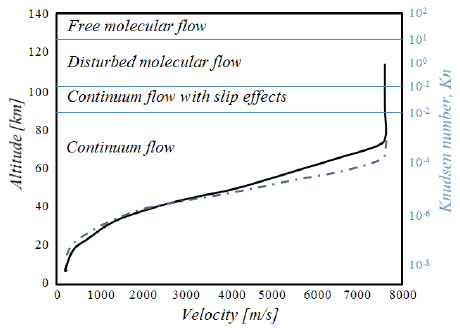
where is the drag coefficient in hypersonic continuum flow and is the drag coefficient in free molecular flow.
The standard atmospheric model in ORSAT is the US Standard Atmosphere, although MSISe-90 is also available. The ablation analysis model of a satellite calculates the temperature distribution of fragments through the zerodimensional (lumped mass) or one-dimensional heat conduction approach. The zero-dimensional heat conduction model only calculates the average temperature of the space object, while the one-dimensional model solves the heat conduction equation in the thickness direction with a partial melting process. Therefore, ORSAT analyzes the survivability of each part through an aerodynamic mass comparison before and after the break-up.
DAS was developed in 1998 as a tool for NASA programs to perform orbital debris assessments (ODAs) according to the NASA Technical Standard 8719.14, Process for Limiting Orbital Debris (NASA ODPO 2012). The NASA Technical Standard (STD) 8719.14, which updates and replaces the NASA Safety Standard (NSS) 1740.14, provides specific requirements and methods to comply with the NASA requirements for limiting orbital debris generation (NASA 2012). Currently, most re-entry analysis tools verify compliance with this standard. DAS uses the same satellite shape model, equation of motion, and heat transfer model as ORSAT. Compared with ORSAT, DAS briefly measures the risk level of the input re-entry mission. The spacecraft to be analyzed is modelled as a set of geometric objects defined by its shape (a sphere, cylinder, box, or flat plate), geometric dimensions, mass, and material. For thermal analyses, DAS uses only a zero-dimensional thermal mass model for solid objects. However, the main important output of DAS is a table with the resulting demise altitudes or the calculated casualty areas for each ground impacting object. The resulting risk of human causalities is calculated directly based on orbital inclination and future world population databases.
According to the NASA Technical Standard 8719.14, the total debris casualty area for a re-entry event is the sum of the debris casualty areas for all debris pieces surviving atmospheric re-entry. This standard specifies upper limits for the acceptable risk. For example, for uncontrolled reentry, the risk of human casualties from surviving debris must not exceed 0.0001 (1:10,000).
Eq. (2) is used to calculate the total debris casualty area. The total casualty area should be less than 8 m2 and the kinetic energy over the time of the fall should be less than 15 J (NASA 2012).(2)
where N is the number of objects that survive re-entry and Ai is the area covered by the surviving pieces. The 0.6 term is then square root of 0.36 m2, which is the average crosssectional area of a standing individual.
The total human casualty expectation, E, can then be simply defined as(3)
where DA is equal to the total casualty debris area and PD is equal to the total average population density for the particular orbit.
DAS should be used for initial risk assessments. If the DAS result indicates a risk greater than 0.0001, an ORSAT assessment will be needed to determine the actual risk.
The ESA space debris mitigation requirements provide fundamental safety and mitigation recommendations related to space debris. The DRAMA software tool suite has been designed to support space missions according to the European Space Debris Mitigation Standard (EDMS) (ESA/ESOC 2017). The DRAMA software suite, which is an objected-oriented tool, enables an assessment of mitigation strategies for the operational and disposal phases of a mission, including the risk posed by a mission’s space debris and the effectiveness of its end-of-life strategy (Fuentes et al. 2017). DRAMA covers all major debris risk assessment and mitigation aspects. The suite consists of 5 types of modules, such as the cross section of complex bodies (CROC), the assessment of risk event statistics (ARES), the meteoroid and space debris terrestrial environment reference (MASTER)- based impact flux and damage assessment (MIDAS), the orbital spacecraft active removal(OSCAR), and the (re-entry) survival and risk analysis (SARA) (Braun et al. 2013; ESA/ ESOC 2017; Fuentes et al. 2017). The CROC module was developed to model a satellite shape (box, sphere, cylinder, or panel), and calculate the cross-sectional area of a satellite model. Its cross-sectional area can be estimated from the difference between aspect angles assuming tumbling motions. The ARES module computes an assessment of risk event statistics; in particular, it analyses collisions between space debris and satellites in operation. ARES functionality allows the annual average risk reduction to be calculated, along with the delta-v and fuel required for collision avoidance maneuvers. The impact and damage risk due to smaller debris and particles can be assessed with MIDAS. Additionally, MIDAS is equipped with a collision flux analysis mode and a satellite failure analysis mode. OSCAR is able to analyze the disposal maneuvers performed by a space system at the end of its useful lifetime. This module offers the functionality to simulate drag augmentation devices as a new disposal system. SARA, which includes the spacecraft entry survival analysis module (SESAM) and spacecraft entry risk analysis module (SERAM), is used to analyze re-entry into Earth’s atmosphere. The main outputs of SESAM are the mass, cross-section, velocity, incident angle, and impact location of the surviving fragments, and these results serve as inputs for SERAM. SERAM performs a risk assessment for a given set of fragments impacting on the ground, and calculates casualty probabilities relating to the fragments and the entire re-entry process.
STELA is a JAVA-based open-source re-entry analysis tool developed by CNES, the French Space Agency. It is a relatively new up-to-date tool for long-term lifetime predictions, and is widely used in mission design and studies. CNES defines technical methods and good practices to address the compliance of disposal orbits with the legal technical requirements. It provides 3 types of mode with respect to the disuse altitude of a satellite: LEO, geostationary orbit (GEO), and geostationary transfer orbit (GTO). Two protected regions, region A for LEO (altitude < 2,000 km) and region B for GEO (GEO – 200 km < altitude < GEO + 200 km; inclination < 15°), have been defined by the IADC. The verification of these rules and criteria requires long-term orbit propagation to evaluate the evolution of orbit parameters, such as drag coefficient and solar activity predictions for LEO, and surface and reflectivity coefficients for GEO. In the LEO (< 2,000 km in altitude) simulation mode, it is possible to provide an efficient lifetime prediction analysis and to judge whether or not a satellite will re-enter Earth’s atmosphere within 25 years. Validation of STELA showed that the 25-year re-entry duration is obtained with a precision of about 1% compared with a full model (Le Fevre et al. 2011). The GEO (>35,786 km in altitude) simulation mode predicts the lifetime of a satellite if a satellite approaches the GEO altitude within 100 years. STELA has a semi-analytic mode and a statistical mode. These two types of mode make long-term accurate trajectory predictions possible using a long-term propagator. A semi-analytic method, which is much better suited to long-term extrapolation than numerical propagation, has been developed. It only considers the dynamical effects that are significant for each orbit type (LEOs and GEOs). As resonance phenomena occur in GTOs, STELA uses Monte- Carlo statistical analyses to analyze them. The US Standard 1976 and NRLMSISE-00 can be selected as the atmospheric model.
Table 2 summarizes the comparison of the representative re-entry analysis tools introduced in this study.
4 APPLICATION OF THE NEW SOLUTION TO THE UPCOMING TIANONG-1 RE-ENTRY
In this paper, an effective re-entry analysis solution is proposed to compensate for the disadvantages of the tools presented above. Fig. 5 shows a flow diagram of the newly proposed integrated hybrid approach for lifetime predictions and re-entry risk assessments. STELA and SARA from DRAMA are conducted for the lifetime analysis and reentry risk analysis, respectively. In the proposed integrated hybrid re-entry analysis approach, the output of STELA’s lifetime analysis module is used as the input value for the SARA module in DRAMA. STELA is characterized by its accurate and efficient performance for satellite lifetime analyses using semi-analytic long-term propagators. In STELA, the user can set up a more realistic environment using various parameters such as the integration step, the number of quadrature points corresponding to atmospheric drag, the solar radiation pressure, the order of the zonal and tesseral perturbation terms, the re-entry altitude, etc. Therefore, STELA begins the calculation from the point where re-entry starts, i.e., 120 km before the aerodynamic heating phenomenon usually occurs. In contrast, in the case of DRAMA OSCAR, calculations are available for fixed 144-minute integral intervals, a re-entry altitude of 120 km, and for limited floating number inputs. To verify the newly proposed approach based on the integration of STELA and DRAMA, an analysis of the re-entry prediction for an upcoming re-entry event was performed.
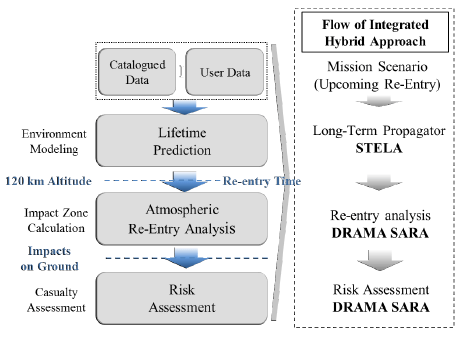
As per a verbal note dated May 4, 2017 from the Permanent Mission of China to the United Nations (UN) addressed to the Secretary-General, the United Nations Office for Outer Space Affairs (UNOOSA) has reissued a notification by China on the future uncontrolled re-entry of the country’s Tiangong-1 Space Lab (UNOOSA 2017). According to the Aerospace Corporation’s re-entry prediction report, Tiangong-1 is currently predicted to re-enter Earth’s atmosphere between December 2017 and February 2018 (Aerospace 2017b).
Tiangong-1 was China’s first space station module designed to develop, build, and operate a large space station as a permanent human presence in LEO. This spacecraft was launched into Earth orbit on September 29, 2011. It was designed to be a manned lab and has 2 modules: a habitable experimental module and a resources module. It was registered under International Designation 2011-053A and US Catalog Number 37820. The dry mass of the spacecraft is 8,500 kg and it is 10.5 m long and 3.4 m in diameter. On March 16, 2016, Tiangong-1 ceased functioning, as declared in an official Chinese statement on March 21, 2016.
Since the detailed specifications of Tianong-1 are not well known, this study assumed a simple model, using estimations where data were lacking. In particular, the geometry of the Tiangong-1 was modeled as a parent module, 2 solar arrays, and 33 main components with several shapes (cylinder, plate, box, and sphere). The NRLMSISE-00 was used as the atmospheric drag model and the influence of solar activity was set to a constant value. Additionally, the initial orbital elements were taken from the latest two-line rlement (TLE) data by the Joint Space Operations Center (JSpOC), which are available online. Table 3 indicates the applied parameters for the Tiangong-1 re-entry prediction.
Fig. 6 shows the simulated evolution of the mean apogee and perigee altitudes of Tiangong-1 using STELA. The output of STELA can provide a variety of information as inputs for DRAMA SARA. The DRAMA SARA module supposes that re-entry happens at 120 km in altitude, and that solar panel separation subsequently occurs at 95 km in altitude. The break-up event due to the destruction of the spacecraft is assumed to occur at 78 km in altitude.
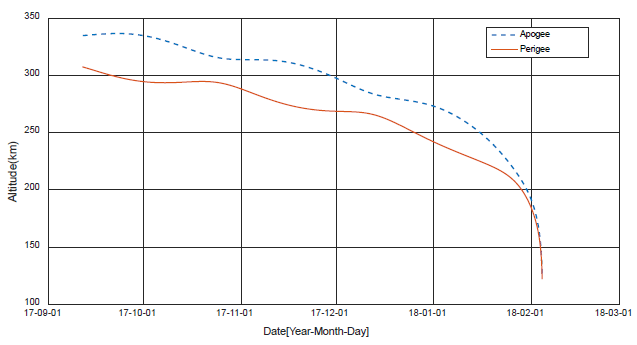
Through DRAMA SARA, the re-entry trajectory of the Tiangong-1 was analyzed in terms of the ground footprint and damage areas. Based on the re-entry analysis by SARA, about 18.7 % of the total mass fell to the ground. Notably, the battery, antenna, and tank, etc., which have large mass and high density, were found to survive. Potentially, parts of spacecraft containing the highly toxic and corrosive substance hydrazine could survive re-entry. Fig. 7 shows that the spacecraft begins its re-entry in China and its fragments fall into the Pacific Ocean. Fig. 8 explains the survivability analysis results for each part. The fragments fall approximately 9,000 km from the re-entry starting location and the duration until ground collision is more than approximately 1,800 seconds after the break-up event. In addition, the probabilities for expected casualties and impact due to the spacecraft’s re-entry as a function of terrestrial latitude are shown in Figs. 9 and 10. The casualty probability density data represents the average, minimum, and maximum cross sections for all objects. As shown in Fig. 10, the impact probability density is highest at 42.78°, assuming a uniform impact probability along the orbit. It was found that, at the time of re-entry, Tiangong-1 passes terrestrial latitudes of 20° to 45°, so the probability of producing casualties is currently high. This result is subject to the population distribution model embedded in DRAMA. The highest casualty probability is shown as 1.48 x 10-5 at latitude of 42.78°, and the impact probability increases at latitudes of more than 40°.
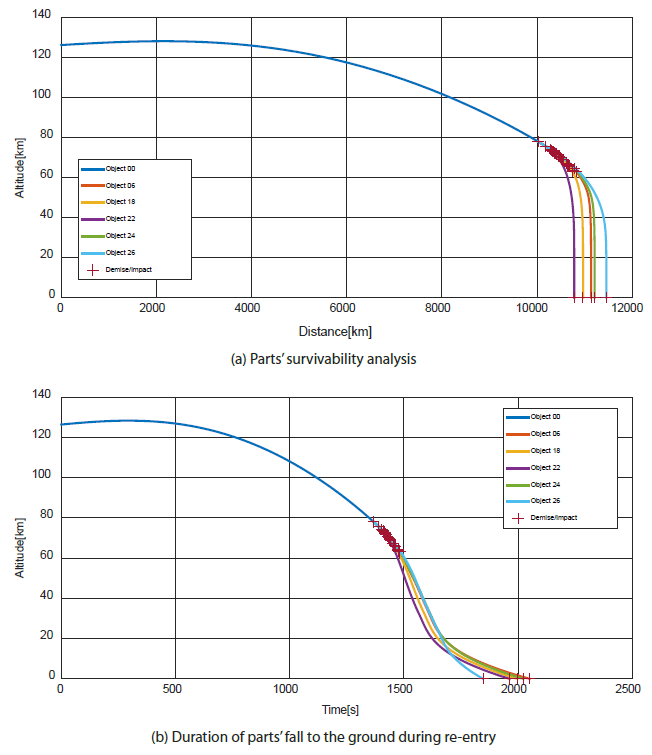
5 CONCLUSION
In this study, an extensive review of various cases of uncontrolled re-entry of space objects was presented. For the re-entry analysis, this study emphasized a performance analysis of representative re-entry analysis tools: SCARAB, ORSAT, DAS, DRAMA, and STELA. In particular, STELA, the most up-to-date analysis tool, has a strong advantage in long-term predictions of the lifetime of space objects reentering Earth’s atmosphere. Additionally, DRAMA provides an effective solution for ground risk assessments considering the impact of debris. Based on the re-entry analysis process, a new integrated hybrid method for both the prediction of space object re-entry and ground risk analyses was proposed. This method integrates a key feature of STELA for long-term lifetime predictions with DRAMA’s risk analysis function for ground impact analyses. The proposed re-entry analysis approach is comprised of two major components: a lifetime analysis using STELA and a re-entry risk assessment analysis using SARA in DRAMA.
To verify the effectiveness of the proposed re-entry analysis and the ground risk assessment, the combined STELA and DRAMA SARA technique was applied to an upcoming re-entry.
An analysis of the re-entry prediction for the Tiangong-1 Space Lab, China’s first space station, was carried out. Currently, Tiangong-1’s re-entry is expected between December 2017 and February 2018. According to the result of the proposed re-entry analysis, Tiangong-1 is likely to fall back to Earth in February 2018. Additionally, the results predicted that components making up 18.7 % of the dry mass will fall to the ground, and the highest casualty probability was analyzed at approximately 1.48×10-5 at latitude of 42.78°. The results show that the proposed integrated hybrid approach for lifetime and ground risk assessments provides a very effective solution for re-entry analysis and management.
Re-entry prediction for uncontrolled satellites close to re-entry is still a challenging activity due to unavoidable uncertainties. However, re-entry predictions for space objects are mandatory and indispensable for national space situational awareness.
Currently, the process for re-entry predictions is undergoing an initial research phase. Although we face many problems that need to be addressed, the efficient preparation for the upcoming uncontrolled re-entry event will be possible through this study, and it is expected that this study may provide important considerations for upcoming re-entry events.
